Conversation with Naomi Chung
by Elizabeth Johnson, edited by Matthew Crain
Conversation with Naomi Chung
by Elizabeth Johnson, edited by Matthew Crain
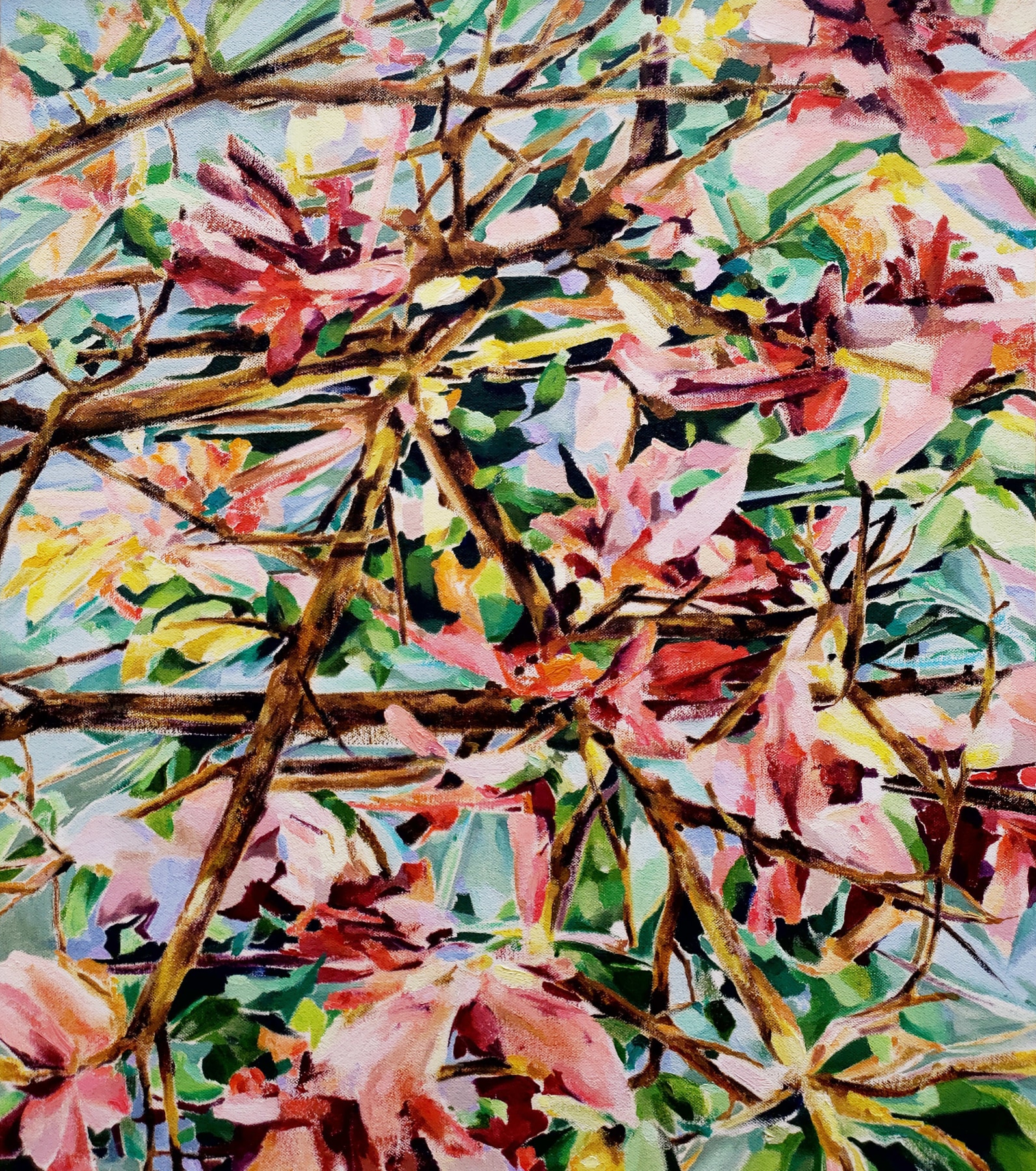
Okame, 20.5" x 18", Oil On Canvas
Elizabeth Johnson: On the Gross McCleaf website you state, "In an attempt to capture the full spectrum of a constantly evolving world, I break down the constraints that a still landscape offers and opt for compositions and environments that appear to be in a constant state of flux.” What attracts you to capturing change as a still image?
Naomi Chung: Before there was a still, captured image there was the experience of being present and taking in all the information visible and invisible. That is where painting becomes a translator of these experiences. The sounds, movements, glimmering light, temperature, breeze, and smells are all evoked in the final painting. I am attracted to images that, through painting, reactivate these non-visual sensory experiences. The viewer is now in front of a painting and using their own recollection or imagination. The experience is activated as much in the mind as in the eye.
EJ: Compositions such as Angel Trumpet and Fanfare are complex from edge to edge. Anthurium and Hovering Philos allow us to peek into deeper spaces. Devil Trumpet and Sitting Riverside frame open space in the background, such as sky or water. Why do you focus sometimes on the interaction of parts of the composition and at other times on creating natural space? Has there been trend over the years?
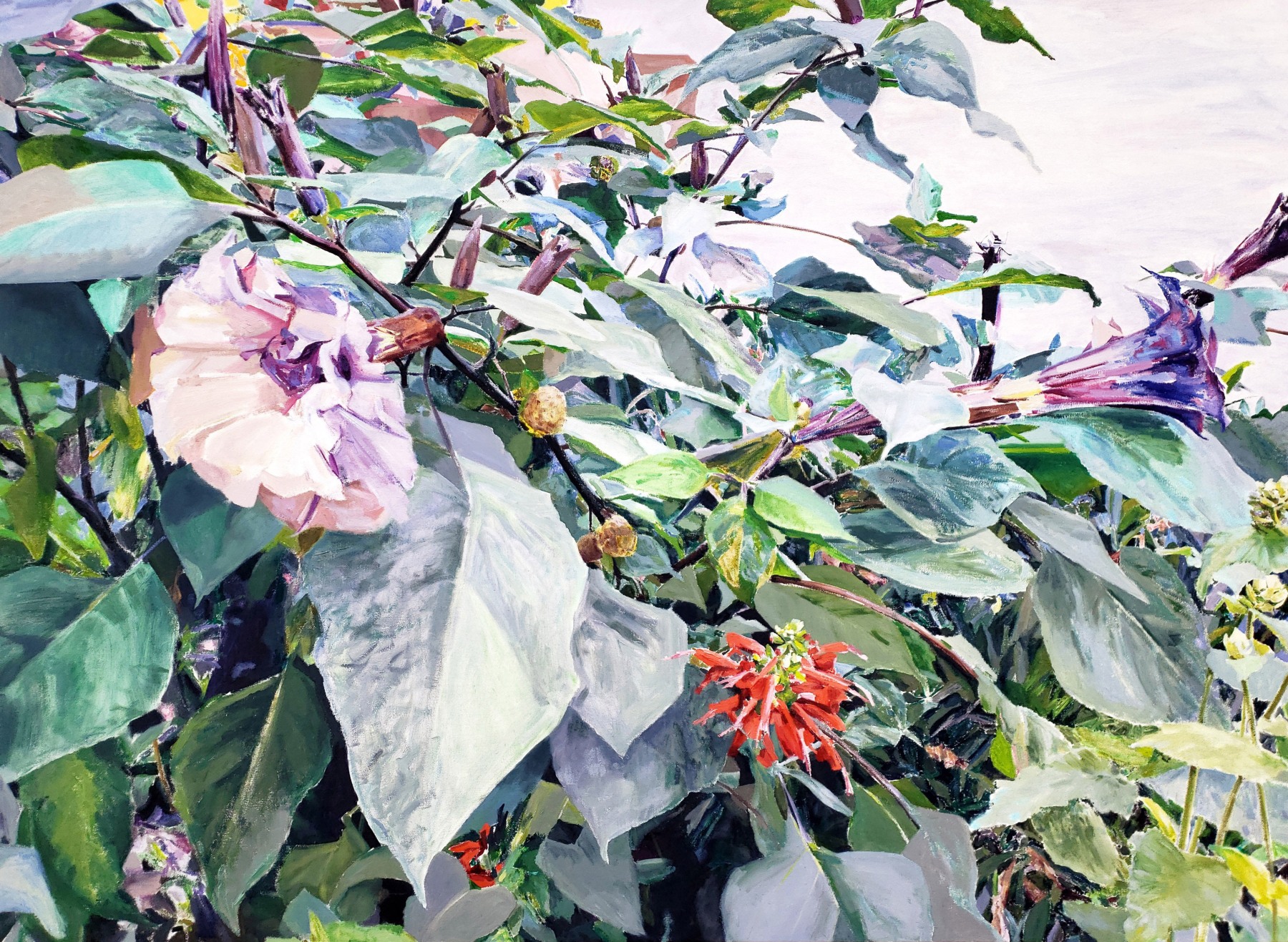
Angel Trumpet, 44" x 59.5", Oil On Canvas
NC: I used to paint deep empty landscapes. It was a time when I was curious about textures and space and how light travels across it. I think these kinds of landscapes are taken in all at once. Lately, I’ve been zooming in a little and looking at the complexity of plant life. These compositions take time to navigate. Some of these might be presented as if something is blocking a broader view of something more beautiful behind it. These unusual scenes that are portrayed might make you second-guess what the main feature really is: are you not able to see the forest for the trees? Or can you accept what’s right in front of you regardless of how it’s presented and appreciate what’s going on? That’s been both a theme in the compositions I seek out and the way I’ve been regarding my daily life. The “scenic view” at the rest stop doesn’t guarantee a profound experience. The canned experience never quite surpasses a discovered one.
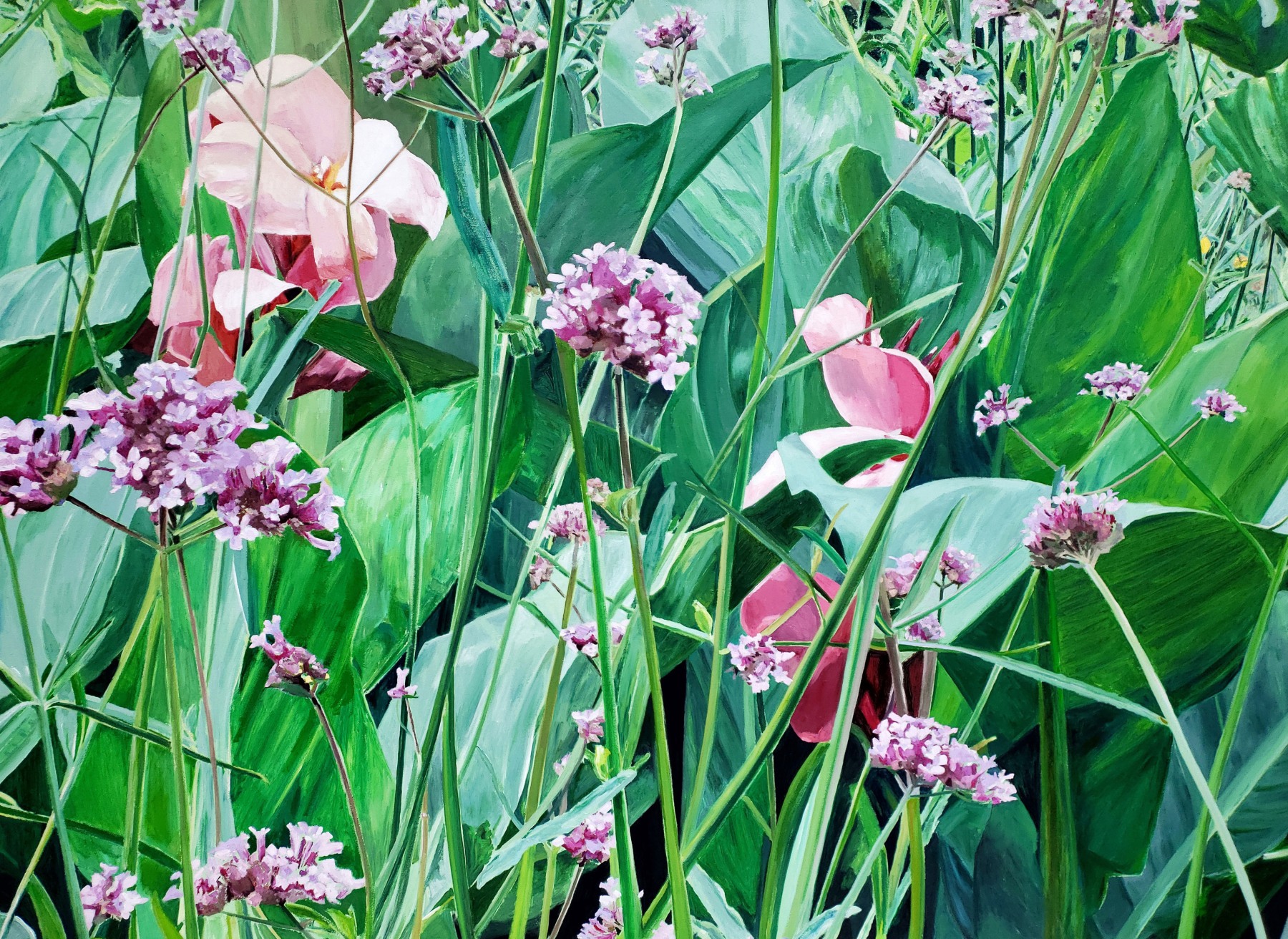
Canna And Verbena, 44" x 59.5", Oil On Canvas
EJ: Your work is both precise and impressionistic. Is part of the fun making order out of chaos? Does the species of flower influence the kind of background you choose?
NC: Yes. I find that the photographic reference lacks the unity that the painting can achieve. I start with a chaotic scene, and through the painting process, I find ways to accentuate patterns that synthesize the whole image. Along with pattern, there is a new language of time, texture, rhythm, motion, and space that is created on the canvas. Often the backgrounds are the last thing considered and they are designed to support or interact with the main subject.
EJ: Sometimes, as in Blue Jay, you paint with more speed and abstraction, and sometimes you paint more realistically, as in Canna and Verbena. Do you feel the need to integrate these two styles? Or do you prefer switching between them?

Yellow Water Iris, 25" x 27.75", Oil On Canvas
NC: I’ve been going back and forth between them to study something different in each approach. I paint realistically to find and study color. I paint abstractly to find compositions and quickly to create movement. But ultimately my aim is to integrate these two approaches. So far, I feel I have done so in Yellow Water Iris and Fanfare and a couple older paintings. Both styles aim to capture movement and patterns, and rhythms of light. Both aim to keep the painting operating continually beyond imagery.
EJ: Do you paint flowers as they are found in nature? Or in gardens and interiors? Do you find any difference?
NC: I prefer painting natural growth patterns, because my painting process mimics how nature behaves. It reacts to cause and effect. Even though there is a preset image with these paintings, something new is always revealing itself in the process of painting and I constantly react to those subtle nuances.
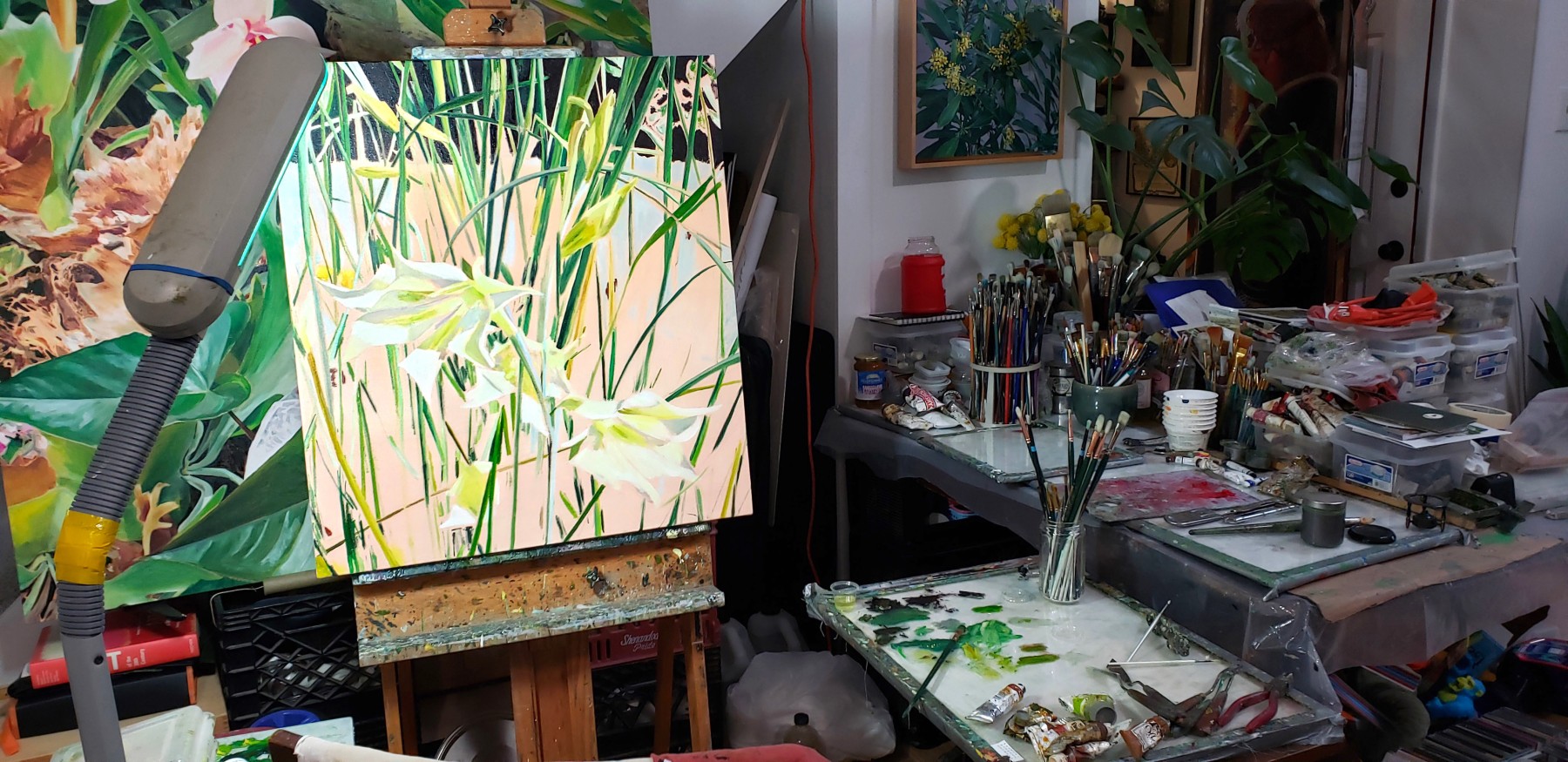
Naomi Chung's Studio, featuring Against Tall Reeds
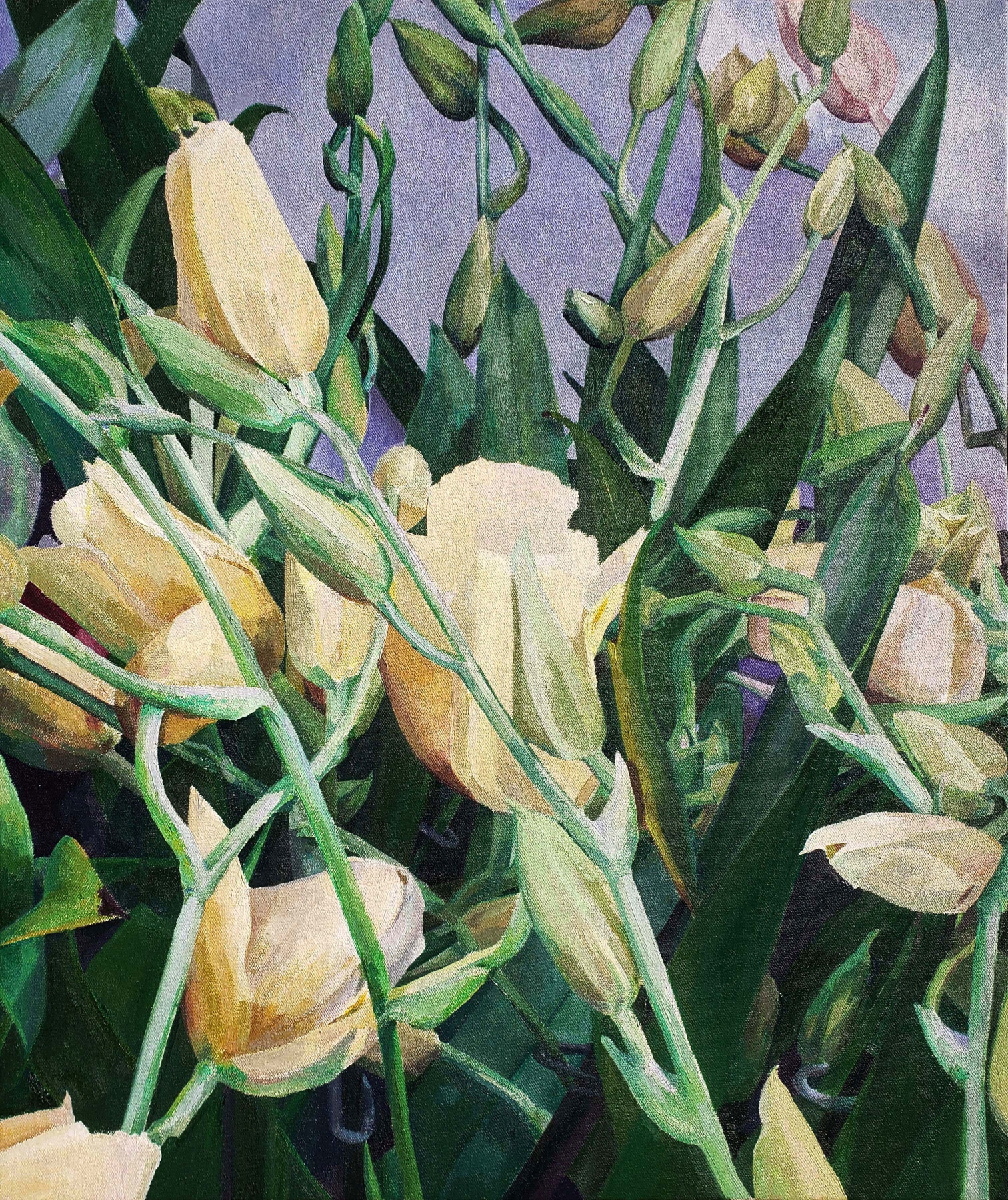
Pale Yellow Orchid, 25" x 21", Oil On Canvas
EJ: What about, say, 17th-century Dutch flower painters? And what about other artists that painted flowers, such as Van Gogh, Manet, Monet, Hiroshige, and Hokusai? What painters influence you? Has ink or watercolor painting technique informed your oil painting?
NC: I’m all across the board. I look at all painters––and many of them don’t paint flowers! Of those that do: Anselm Kiefer––particularly his series Let a Thousand Flowers Bloom––and Van Gogh, although he has had more of an impact on my view of being an artist. He once wrote to his brother about a color he loved. He responded so deeply about color and that was enough. I love the Impressionists, Post-Impressionists, and Expressionists. And while I do love Japanese woodblock artists, I’m inspired more by how Les Nabis artists took their concept of patterning and flattening space and integrated it with nature, not with linework and carving but through the language of painting. I’m also inspired by Itō Jakuchū’s work. I’ve always liked fluid calligraphic ink brushwork but never studied it in depth. I do see characteristics of it in my oils and it seems to be there to offer movement, direction, and a casual elegance.
EJ: I can see why you like Jakachū. He uses bold color and aggressive compositions that bring animals, vegetables, and flowers to life. He seems also to work with allegory.
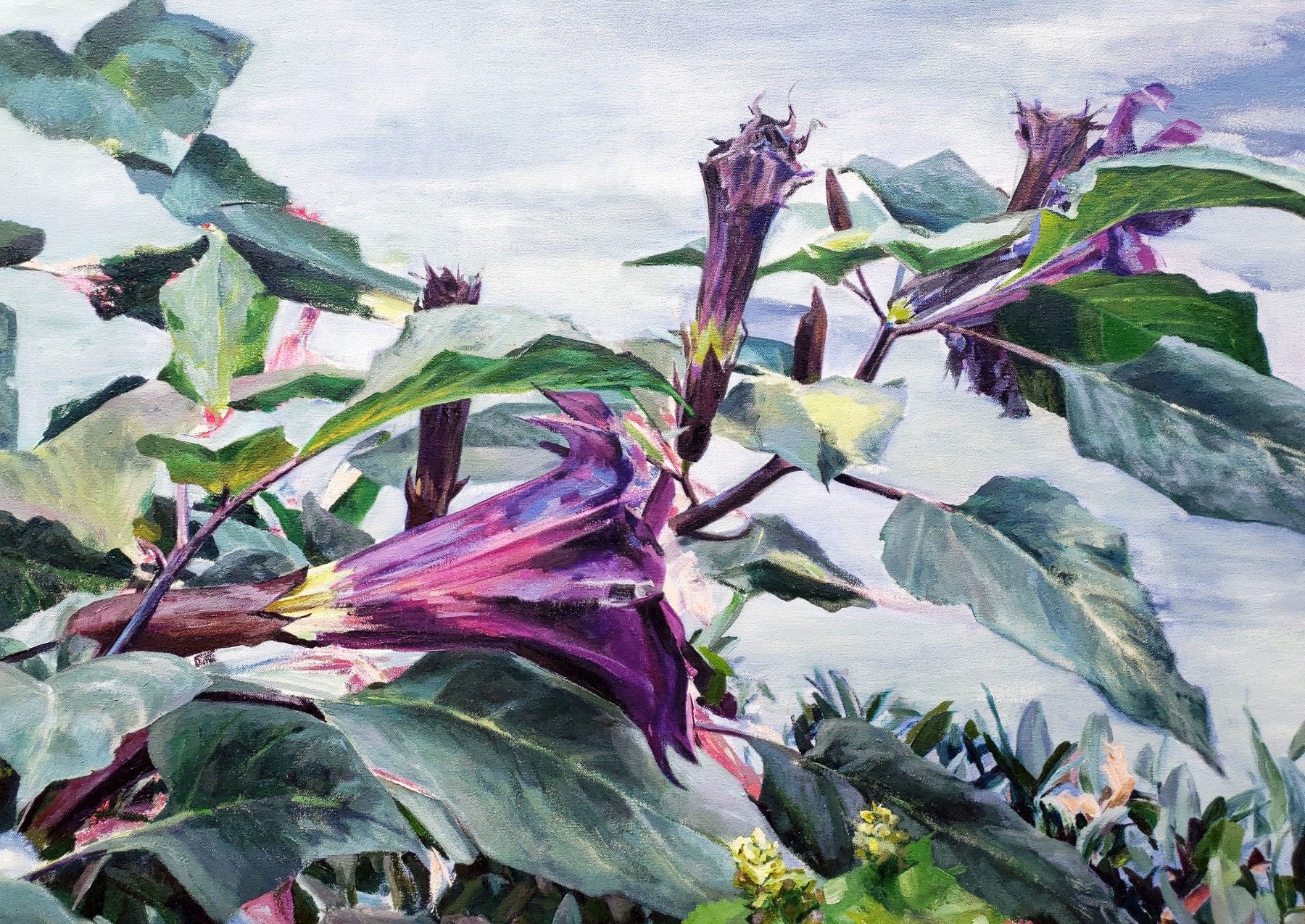
Devil Trumpet, 26.25" x 36", Oil On Canvas
EJ: Your painting Devil Trumpet contrasts the dying part of the plant with the living part. Do you think of paintings as embodying stories, or even the drama of living and dying?
NC: Exactly. The Devil Trumpet or Datura flowers are poisonous yet so beautiful and short-lived, each flower blooming for less than twenty-four hours. The flowers initially were a means to study colors and compositions, but in the process of creating this body of work I suffered a great loss in my life, and they started to carry symbolism. Their impermanence and fragility were met with the strength, complexity, and wisdom of the way things are, both an acceptance and celebration of life. It’s no wonder flowers are used in all of life’s milestones whether tragic or celebratory.
EJ: Speaking of Van Gogh, I love his letters. For color, one of my favorites is the one he wrote to Theo on October 28, 1885. It’s fall, he’s eager for the fall colors. He mentions Tulip Mania, and then he digresses:
"Then an autumn landscape with foliage from deep wine red to vivid green, from bright orange to dark havana, with yet more colours in the sky in greys, lilacs, blue, white, forming another contrast to the yellow leaves.
Then again a sunset in black, in violet, in fiery red.
Then again more capricious, like the corner of a garden by him that I saw and have never forgotten; black in the shadow, white in the sun, bright green, a fiery red, and then again a dark blue, a bituminous greenish brown and a light brownish yellow. Truly colours that can have quite a lot to say to one another."
EJ: This man’s world was a riot of color.

Sitting Riverside, 18.25" x 20.5", Oil On Canvas

Against Tall Reeds, 26.5" x 29.5", Oil On Canvas
EJ: On your website under “Selected Works” I find emptier, greyer landscapes. There are oceans and fields, and sometimes tree branches in front of them. Why has your work become more intimate and colorful?
NC: I’ve taught color theory for the past 10 years, and it naturally found its way in my work. I immerse myself in teaching, deepening my own understanding of the subject in the studio while teaching it to others.
EJ: Your compositions achieve their complexity by how you unify the light, by how you make patterns from varying degrees of brightness and shadow. Do you work from life and photos? Primarily from photos? Do you ever work from memory?
NC: I’m very much interested in creating patterns, whether through hue or value or through line and shape. This body of work mainly came from photos, and previous works came from memory, but both involved my own reactions to the paint and brushwork at every stage in the process. Through painting, the patterning becomes much more accentuated because of this back-and-forth dialogue between me and the paint. There is a rhythm to the compositions in which light plays a major part.

Staghorn Fern, 44" x 48", Oil On Canvas
EJ: In your artist statement you speak of wholeness: "The resulting imagery aims to resonate like a single chord being struck, complete with nuances of each individual note playing its part to make a harmonious sound.” Does working from photographs unify the image for you? Would you agree that the refracted or exaggerated light effects and the recorded color of photographic images enhance painting from them?
NC: I think the process of painting unifies the image. I know how wildly color can change in nature when observing it because light is constantly changing. So, the photo just keeps the color still for me. It’s more a convenience thing and a means to an end. I get a general idea of what happens with color and how varied it is within one object. I don’t paint onsite or from a still life but it is something I would like to do. My dream would be to cultivate a garden for painting in and to have the daylight hours to paint. Right now, I don’t currently have the luxury of either of those.
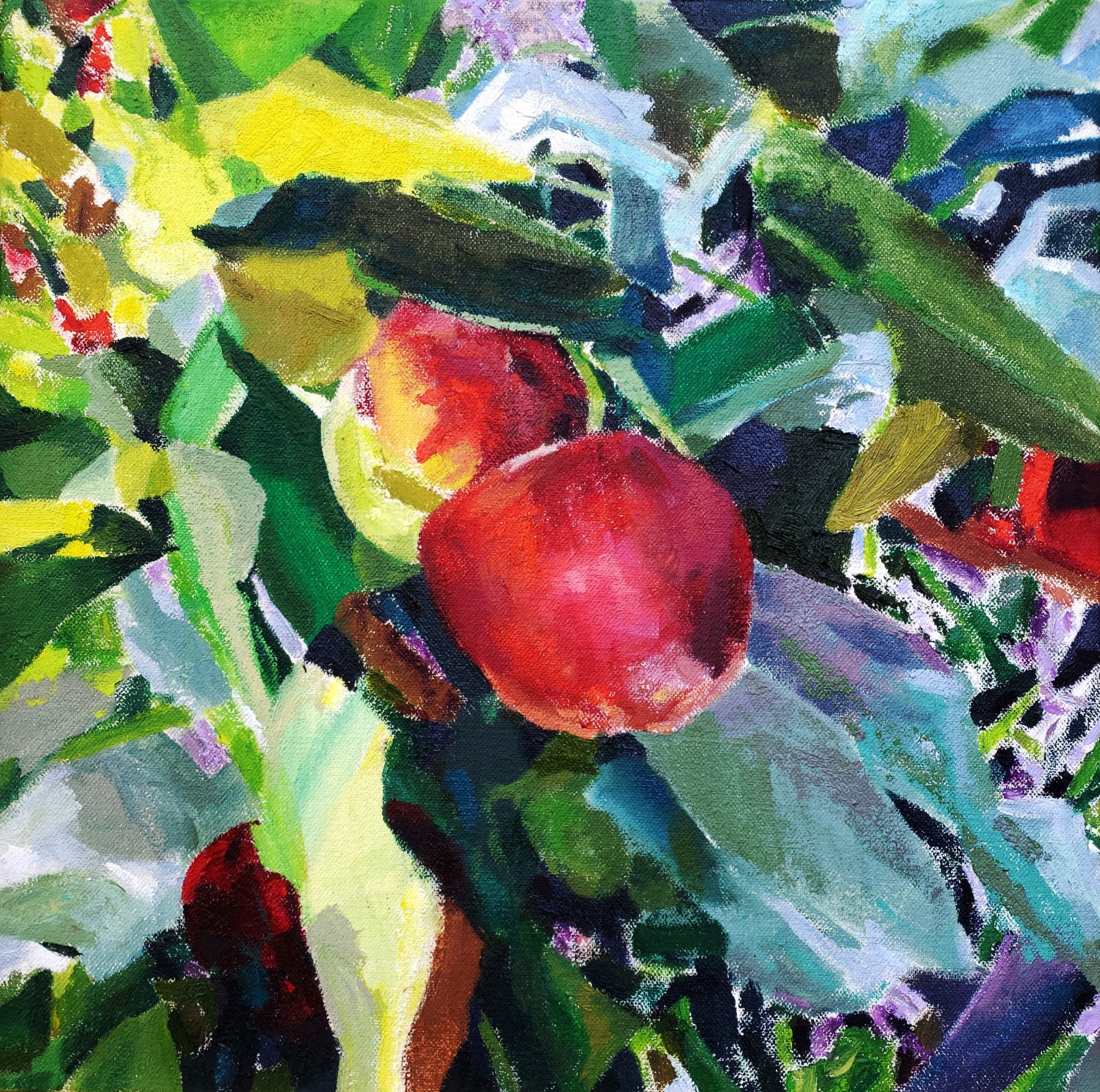
Apples II, 12" x 12", Oil On Canvas
EJ: Do you take your own photos? Do you think of the eye of the camera as a "truer" point of view or one that codifies distortions as does the human eye? Does the gloss or matte surface of photos affect you?
NC: Yes. I do take my own photos. And what I get from them is mostly color. I unify them in the process of editing and painting. I approximate so the gloss and matte doesn’t bother me. I don’t accept every color at face value as it’s rendered by the camera.
EJ: Are there any flower paintings you dislike? For instance, Picasso? I imagine his simplification would work against your grain.
NC: I really dislike fake flowers and some paintings have that same artificial quality in the color and texture. Some of the Fauves and French Symbolists had that effect when they painted flowers, especially when the palettes were somewhat limited to the primaries and all in full saturation. But Picasso, I have no problem with!
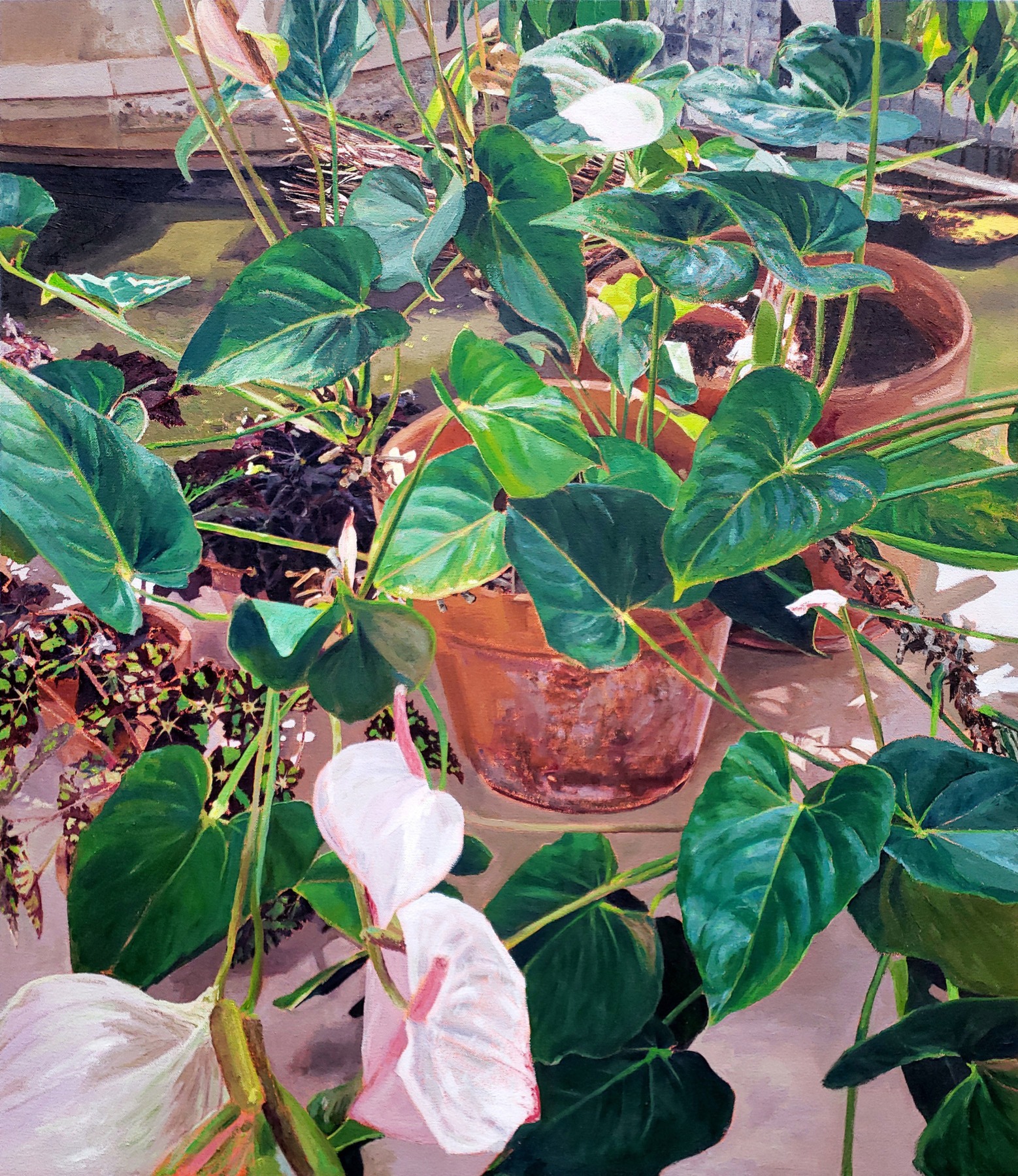
Anthurium, 35.25" x 30", Oil On Canvas
EJ: Would you include flower photographers as an influence? Say, Robert Mapplethorpe? Andy Warhol’s giant hibiscus blossoms?
NC: I think Ori Gersht has done some beautiful things in his photographs and films with flowers as well as expressing the impermanence of nature. I’m also interested in films that capture a quality of the landscape that’s filled with an unspoken presence. The opening sequence of Herzog’s Heart of Glass, scenes from Yto Barrada’s The Botanist, and Kurosawa’s Rashomon present nature as something that holds a deep awareness or knowledge of life, where man is not in conflict with nature but is a part of it.
––Elizabeth Johnson
(elizabethjohnsonart.com)
edited by Matthew Crain
(Instagram: sarcastapics)
January 2023
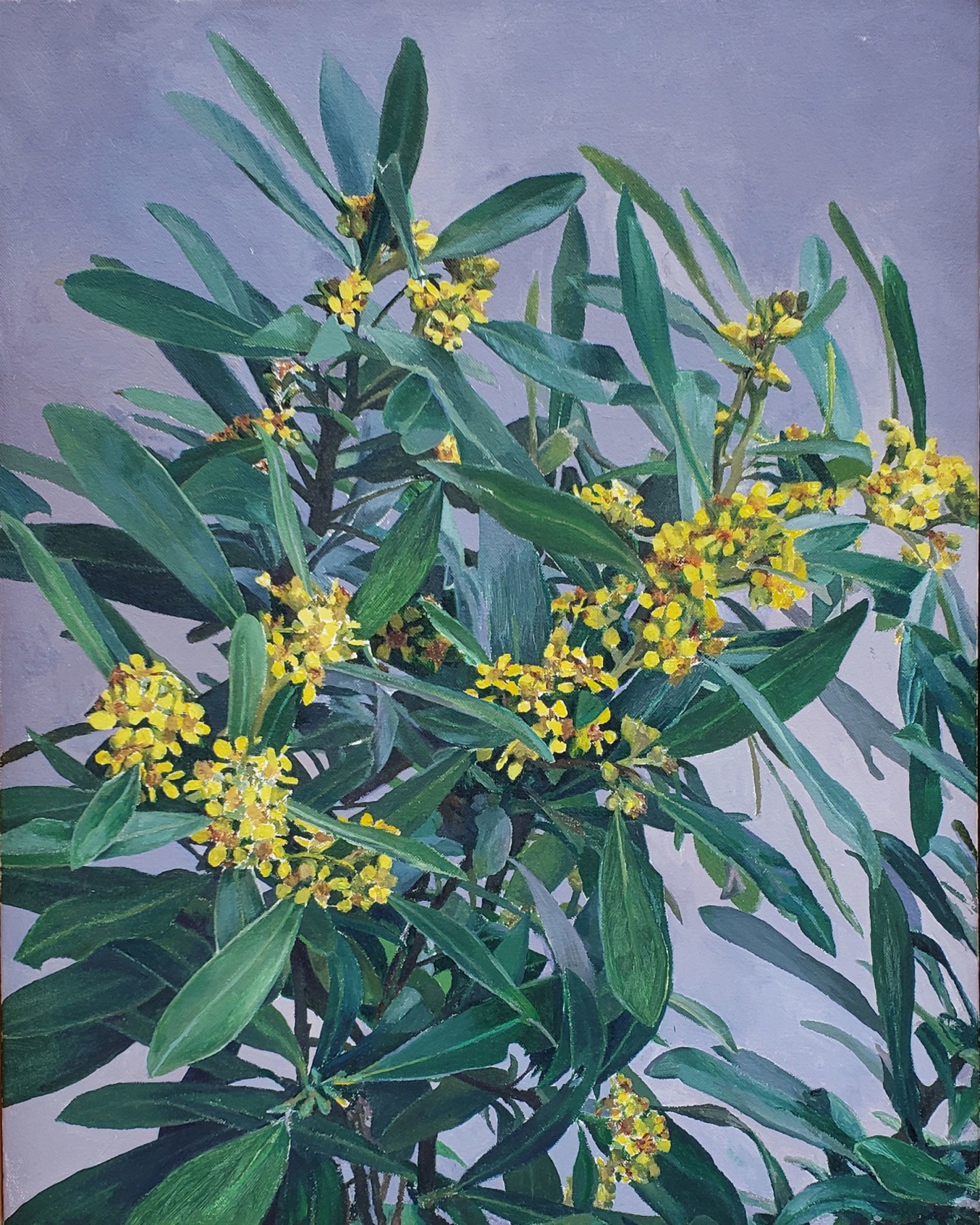
Green And Gold, 20" x 16", Oil On Canvas